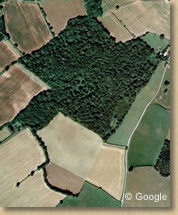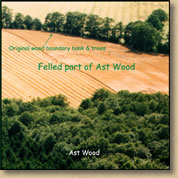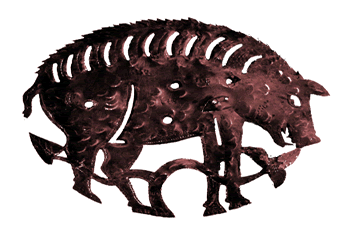Ast Wood is centuries old

Ast Wood still intact in 1969

A substantial area had been felled for arable by the millennium...

...but the original boundary bank and its impressive trees still survive.
Ast Wood is ancient. William the Conqueror’s Domesday Survey compiled about 1086 AD listed woodland which pays 17d
among the assets of the manor of Little Marcle (which included Aylton). This was likely to have been Ast Wood.
Later it was owned by the Little Malvern Priory of Benedictine monks (founded 1171), who probably cleared some of it. When the monasteries were dissolved, a valuation tells us that 1s 4d was received annually from the wood at that time.

Hedges close to Ast Wood surround some fields probably named by the monks, and other hedges may be older. Parish and manor boundaries are especially likely to be ancient and the Pixley/Aylton boundary runs a field's width away from Ast Wood on the far side of the monks' fields, while that of Aylton/Little Marcle is the wood's own boundary. Ast Wood was sometimes called Great Coppice
, according to a 1617 deed among the Harley records held at Brampton Bryan Hall, relating to the Manor of Aylton and which refers to two parcels of woodground called Greate Coppice als. Astwood (48a), and Little Coppice (4a)
.
Like most native English woodland, and as its alternative name suggests, Ast Wood will have been managed throughout most of the centuries by coppicing portions of it at intervals while leaving some trees to grow tall for timber. This technique is called coppice with standards. The late 20th century was a bad time for English woods and like many others, Ast was left un-coppiced & overgrown, causing some hazel understorey to die out. Trees and rides were damaged by war games and 4-wheel driving, and the wood was littered with old tyres & plastic tapes; intensive pheasant rearing reduced groundflora diversity and left a woodland floor legacy of old wire netting, plastic bags and sheets of corrugated iron; two small area of conifers were planted to replace the native broadleaved trees; and in the 1970s - perhaps the worst period of all for native woodlands - a third of the wood was felled for agriculture. However, when developers tried to turn the remainder into golf course fairways in the 1980s, the importance of such woodland was recognised and permission refused.
Click here to show/hide an interactive Google map of Ast Wood.
